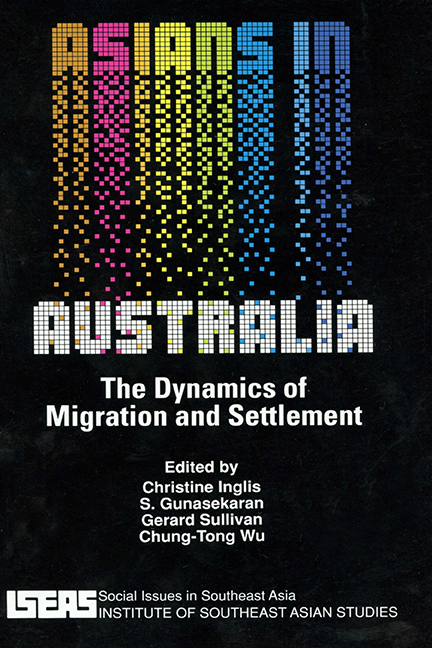Book contents
- Frontmatter
- Contents
- List of Tables
- List of Figures
- Introduction
- 1 China's Policy Towards Migrants, 1842–1949
- 2 Japanese Emigration Policy, 1880–1941
- 3 The “New” Migration and Australian Immigration Policy
- 4 Patterns of Settlement in Australia of Indochinese Refugees
- 5 Labour Market Outcomes Among the Chinese at the 1986 Census
- 6 Is There An Asian-Australian “Brain Drain”?
- 7 The “New” Migration of Asian Skills and Capital to Australia
2 - Japanese Emigration Policy, 1880–1941
Published online by Cambridge University Press: 21 October 2015
- Frontmatter
- Contents
- List of Tables
- List of Figures
- Introduction
- 1 China's Policy Towards Migrants, 1842–1949
- 2 Japanese Emigration Policy, 1880–1941
- 3 The “New” Migration and Australian Immigration Policy
- 4 Patterns of Settlement in Australia of Indochinese Refugees
- 5 Labour Market Outcomes Among the Chinese at the 1986 Census
- 6 Is There An Asian-Australian “Brain Drain”?
- 7 The “New” Migration of Asian Skills and Capital to Australia
Summary
The modern history of migration is in part a demonstration of power. Many might migrate, the powerful to exercise permanent sway over virgin, rich land; the powerless as near-slaves, on a temporary contract on a plantation. And power, more often than not, had a racial basis. White settlers claimed new lands, displaced aborigines, and restricted, and increasingly excluded, Asians from their territory. From 1870–1914 mankind had moved in two massive streams: 36 million Europeans sought permanent residence in largely temperate lands; a slightly larger number of Asians moved, often on contract, as temporary labourers. The streams were almost equal, the rewards were not. Europeans peopled the Americas and Australasia, and excluded Asians from their midst and many of their possessions. Even in Africa the restrictions on Asiatic migration increased with time. White supremacy reached its zenith before World War II. Japanese migration, however, challenged the White-ordained division of the world. It did not overcome it, but Japan alone of the Asian nations modified White power. As Elizabeth Schumpeter succinctly writes: “The net emigration of Japanese has been surprisingly small in view of the extent of the popular agitation against it and the number of diplomatic crises il has precipitated” (Schumpeter 1940, p. 70).
The initial focus of this chapter is upon a brief but crucial period. In 1890, Japan could hope to foster economic growth by giving labour, capital and trade free play. The only obstacles were the unequal treaties, which permitted the great powers considerable, but unreciprocated, access to Japan. Until the treaties were revised in the mid-1890s, Japan had not encouraged migration lest its nationals be treated with the indignity of Chinese coolies. Once the treaties were revised, the Japanese entertained high hopes of migration, only to find that White-settler societies in Australasia and North America imposed sharp restrictions on Japanese nationals. Between 1906 and 1908, the migrant issue seemed likely to precipitate a war.
- Type
- Chapter
- Information
- Asians in AustraliaThe Dynamic of Migration and Settlement, pp. 23 - 44Publisher: ISEAS–Yusof Ishak InstitutePrint publication year: 1992



